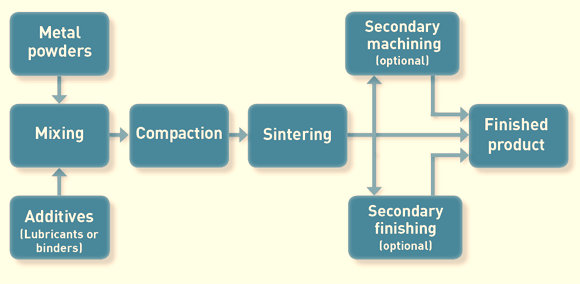Table of Contents
Introduction of Powder Metallurgy
Powder metallurgy is a manufacturing process for producing finished or semi-finished products by compacting metal powders into a suitable matrix. This is one of the least expensive processes that provides high quality, high strength, and complex geometries with high accuracy. These factors make this process most suitable for mass production. It mainly involves four basic steps.
- Powder preparation:
- Mixing and blending:
- Compression:
- Sintering:
This process is a secondary operation such as sizing, embossing, infiltration and hot forging.
Powder metallurgy is a continuously growing technology. Almost all metals can be cast using the powder metallurgy technique, but most often iron powder is used with strength-enhancing alloying elements such as copper and graphite.
Powder Metallurgy Process
Powder metallurgy process is completed in 4 steps. These 4 steps are:
- Powder Preparation
- Mixing
- Compaction
- Sintering
See the below image of powder metallurgy process to understand it better.

1. Powder Preparation
This is the first fundamental step in creating an object by powder metallurgy. Any substance can be turned into powder. There are various processes that produce powders, such as atomization, grinding, chemical reactions, and electrolytic processes.
2. Mixing
High-strength alloy material according to product requirements. This process evenly distributes the powder, including additives, binders, etc. Lubricants are sometimes added during the mixing process to improve powder flow properties.
3. Compression:
Compression means compressing the prepared powder mixture into a given matrix. This step reduces voids and increases product density. This powder is shaped under pressure to form a product called a green body (the product is obtained by compression). Pressure range from 80 to 1600MPa. This pressure depends on the properties of the metal powder and binder.
For soft powders the pressure is about 100-350 MPa. For
steel, iron, etc., the pressure is 400-700 MPa.
4. Sintering:
Green compacts made by pressing have low strength and cannot be used as final products. In this step, the green bodies are heated to high temperatures to ensure strong and lasting bonds between adjacent grains. This process gives the biomass strength and turns it into a finished product. The sintering temperature is generally about 70 to 90 percent of the melting temperature of the metal powder.
5. Secondary Operations
Sintered bodies are more porous compared to fully dense materials. Product density varies depending on pressing capacity, sintering temperature, pressing pressure, etc. In some cases, some products do not require high density and the sintered product is used directly as the final product. However, where sintered products cannot be used as finished products, high-density products may be required (eg for the production of bearings).
Therefore, a second pass is required to achieve high density and high dimensional accuracy. The most commonly used secondary operations are sizing, hot forging, stamping, infiltration, impregnation, etc.
Benefits of Powder Metallurgy
- Powder metallurgy is cost-effective for mass production as there are no labor costs or additional processing costs.
- This method does not require a skilled operator.
- Some alloys can only be made with this powder metallurgy technology.
- High production rate. It is possible to produce 500 to 1000 pieces per hour.
- Complex shapes can be manufactured.
- Bimetallic and laminate products are easily manufactured using the powder metallurgy process.
Drawbacks
- Equipment cost is high.
- Economical for mass production only. Complex designs are difficult to manufacture due to the poor flowability of metal powders.
- It is not possible to produce a product with a perfectly uniform density.
- Due to the capacity of the press, there is a limit to the size of the product.
- Some metal powders that are powdery and potentially explosive cannot be used.
- Low impact and fatigue properties of the final product. Casting low melting point metals with
- Powder metallurgy technology is difficult.
Application/Uses of Powder Metallurgy
- Cutting tools such as carbide tools and ceramic tools are powder metallurgy products.
- Graphite mixed Cu and Ag electrical bushings are powder metallurgy products.
- Nozzle are made for rockets and missiles.
- For small parts in automotive and appliance applications, the ability to create near-net shapes with minimal machining results in significant economic advantages.
- This process used in in bearings, bushings, etc.
